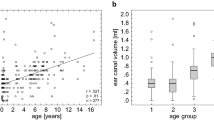Abstract
The aim of the present paper was to review the current knowledge on multi-frequency tympanometry and explore its role as a diagnostic tool in various otologic conditions. Literature review in Medline and other database sources. Prospective controlled, prospective comparative, and prospective cohort studies, animal studies, retrospective studies and systematic reviews. Multi-frequency tympanometry provides more accurate and detailed information about the middle ear dynamics than standard tympanometry. Otosclerosis and rheumatoid arthritis characteristically increase the resonant frequency (RF) of the middle ear. Ossicular chain discontinuity, atelectatic tympanic membrane, and otitis media with effusion typically decrease the RF of the middle ear. Multifrequency tympanometry can also assess the stage of rheumatoid arthritis in the presence of middle ear involvement. The RF can be affected by the mechanical impedance of the cochlea, and multi-frequency tympanometry can be helpful in the diagnostic workup of LVAS. Multi-frequency tympanometry can be a useful tool to predict the diagnosis of various middle ear pathologies preoperatively, due to the ensuing changes in the RF of the mechano-acoustic system of the middle ear, which can be accurately determined when this methodology is applied.


Similar content being viewed by others
References
Terkildsen K, Thomsen K (1959) The influence of pressure variations on the impedance of the human ear drum. J Laryngol Otol 73:409–418
Holte L (1996) Aging effects in multifrequency tympanometry. Ear Hear 17:12–18
Lilly DJ (1984) Multiple frequency, multiple component tympanometry: new approaches to an old diagnostic problem. Ear Hear 5(5):300–308
Zwislocki JJ (1962) Analysis of the middle-ear function. Part I: input impedance. J Acoust Soc Am 34:1514–1523
Moller AR (1963) Transfer function of the middle ear. J Acoust Soc Am 35:1526–1534
Coletti V (1977) Multifrequency tympanometry. Audiology 16:278–287
Vanhuyse VJ, Creten WL, Van Camp KJ (1975) On the W-notching of tympanograms. Scand Audiol 4:45–50
Margolis R, Goycoolea HG (1993) Multifrequency tympanometry in normal adults. Ear Hear 14(6):408–413
Shanks JE, Wilson RH, Cambron NK (1993) Multiple frequency tympanometry: effects of ear canal volume compensation on static acoustic admittance and estimates of middle ear resonance. J Speech Hear Res 36:178–185
Hanks WD, Rose KJ (1993) Middle ear resonances and acoustic immittance measures in children. J Speech Hear Res 36:218–222
Valvik B, Johnsen M, Laukli E (1994) Multifrequency tympanometry. Audiology 33:245–253
Hanks WD, Mortenson BA (1997) Multifrequency tympanometry: effects of ear canal volume compensation on middle ear resonance. J Am Acad Audiol 8:53–58
Shahnaz N, Polka L (1997) Standard and multifrequency tympanometry in normal and otosclerotic ears. Ear Hear 18:268–280
Wada H, Koike T, Kobayashi T (1998) Clinical applicability of the sweep frequency measuring apparatus for diagnosis of middle ear diseases. Ear Hear 19(3):240–249
Wiley TL, Cruickshanks KJ, Nondahl DM, Tweed TS (1999) Aging and middle ear resonance. J Am Acad Audiol 10:173–179
Miani C, Bergamin AM, Barotti A, Isola M (2000) Multifrequency multicomponent tympanometry in normal and otosclerotic ears. Scand Audiol 29(4):225–237
Nakashima T, Ueda H, Furuhashi A, Sato E, Asahi K, Naganawa S, Beppu R (2000) Air–bone Gap and resonant frequency in large vestibular aqueduct syndrome. Am J Otol 21:671–674
Ogut F, Serbetcioglu B, Kirazli T, Kirkim G, Gode S (2008) Results of multiple-frequency tympanometry measures in normal and otosclerotic middle ears. Int J Audiol 47:615–620
Franco-Vidal V, Legarlantezec C, Blanchet H, Convert C, Torti F, Darrouzet V (2005) Multifrequency admittancemetry in Meniere’s Disease: a preliminary study for a new diagnostic test. Otol Neurotol 26(4):723–727
Shahnaz N, Davies D (2006) Standard and multifrequency tympanometric norms for Caucasian and Chinese young adults. Ear Hear 27(1):75–90
Colletti V, Fiorino FG, Sittoni V, Policante Z (1993) Mechanics of the middle ear in otosclerosis and stapedoplasty. Acta Otolaryngol 113(5):637–641
Giannini P, Marciano E (1997) Middle ear involvement in children with chronic rheumatoid arthritis. Eur Arch Otolaryngol 254(S1):S30–S33
Frade C, Martin C (1998) Diagnostic value of the multifrequency tympanometry in active rheumatoid arthritis. Auris Nasus Larynx 25:131–136
Ferekidis E, Vlachou S, Douniadakis D, Apostolopoulos N, Adamopoulos G (1999) Multiple-frequency tympanometry in children with acute otitis media. Otolaryngol Head Neck Surg 121:797–801
Lai D, Li W, Xian J, Liu S (2008) MFT in adults with otitis media with effusion. Eur Arch Otorhinolaryngol 265:1021–1025
Margolis RH, Hunter LL, Giebink SG (1994) Tympanometric evaluation of middle ear function in children with otitis media. Ann Otol Rhinol Laryngol 103:34–38
Darrouzet V, Dulon D, Franco-Vidal V (2007) Multifrequency immittancemetry in experimentally induced stapes, round window and cochlear lesions. Audiol Neurotol 12:85–100
Sato E, Nakashima T, Lilly D et al (2002) Tympanometric findings in patients with enlarged vestibular aqueducts. Laryngoscope 112:1642–1646
Conflicts of interest
None.
Author information
Authors and Affiliations
Corresponding author
Rights and permissions
About this article
Cite this article
Iacovou, E., Vlastarakos, P.V., Ferekidis, E. et al. Multi-Frequency Tympanometry: Clinical Applications for the Assessment of the Middle Ear Status. Indian J Otolaryngol Head Neck Surg 65, 283–287 (2013). https://doi.org/10.1007/s12070-011-0470-9
Received:
Accepted:
Published:
Issue Date:
DOI: https://doi.org/10.1007/s12070-011-0470-9




